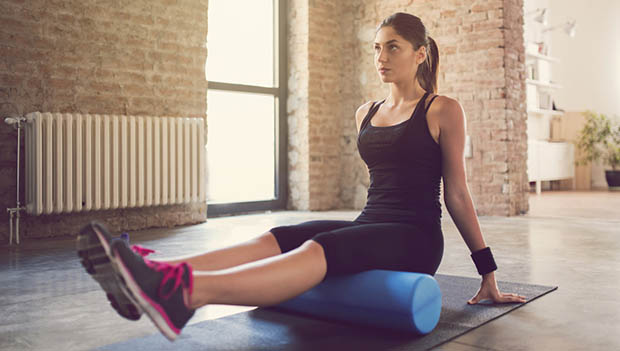
You may not know this, but performance gains don't happen while you're running; they happen between your workouts, during recovery. While the importance of complete rest days and cross training can't be denied, you can take your recovery to a whole new level by sneaking in these little recovery-enhancing tricks any time of day.
Running Events Near You
First Thing in the Morning
Be nice to your body by starting your day with a gentle progression of mobility exercises. Spending just 20 to 30 seconds on each of these movements will leave you feeling limber and ready to tackle the day: trunk twists, windmills, arm circles, butt kicks, toy solder walks, forward/backward leg swings and side-to-side leg swings.If all that is too strenuous for the crack of dawn, start off easy by rolling your bare feet over a small ball to loosen up the fascia. Start off gently with a tennis ball, then progress to a lacrosse ball, a golf ball or even a knobby therapy ball designed just for this purpose. Research has shown that releasing the fascia in the feet and ankles can reduce the incidence of plantar fasciitis.
Before and After You Run
Foam rolling is a great way to recover better, and it makes for a great pre-run warm-up, but many runners never use this indispensable tool. To be sure you don't miss out on the huge benefits, make it a rule to spend five to 10 minutes on your foam roller before every run. Hit your hips, quads, hamstrings and the dreaded IT band, then grab that lacrosse ball again and spend a minute rolling out the bottoms of your feet. One study showed that releasing the plantar fascia resulted in an immediate improvement in both hamstring and lumbar flexibility.After you run, cooling down with some static stretching can help improve flexibility and range of motion. Focus on stretching the muscles you just used: hip flexors, quadriceps, hamstrings, glutes, lower back, calves and ankles. You can even stretch your feet by alternatively flexing and pointing them or pushing your toes toward the bottom of your foot.
Throughout the Workday
Though not strictly a recovery trick, strengthening the stabilizer muscles of your lower legs, ankles and feet can help you run stronger and prevent injury, especially on uneven surfaces. One of the best ways to work all three of these areas is by simply balancing on one foot. It only takes a minute to stand up from your desk and stand on one leg for 30 seconds on each side. For maximum effect, slip off your shoes and do it in your socks or barefoot.Foam rolling is so effective that it shouldn't be limited to just five minutes before you run: In one study, it was shown to cut recovery time in half! And since sitting for hours on end is so bad for you, why not take a short break every hour or so and work on tight areas with a foam roller? A half-sized roller can easily be stowed under your desk at work, and you only need an area the size of a yoga mat to give yourself a therapeutic massage in the middle of the workday.
On the Couch
While foam rollers are great for the larger muscles of the hips, glutes and thighs, they're not quite as effective on the smaller muscles of the lower leg. Luckily, there are specialized massage devices, like The Stick, that are perfect for releasing tension in these areas. Don't want to shell out the dough for one? Some people use an old-fashioned rolling pin for the same effect. And it's so easy to loosen tight calves and shin muscles with these devices that you can even do it while bingeing on your favorite TV shows.Rolling out tight muscles isn't the only thing you can do while you're relaxing. Why not grab a looped resistance band and strengthen your hips with a few side-lying leg raises and clamshells? Strong abductors can shore up bad running form and help prevent and even rehabilitate IT band syndrome.
At Bedtime
Maybe the most important part of recovery is sleep. Did you know that your sleep quality may be suffering because of your mobile phone? A number of studies have linked poor sleep quality and the blue light emitted by mobile devices. The closer to bedtime you look at your phone, the worse the effect—but the fix is easy. An hour before bedtime, take five seconds to put your phone into airplane mode. With Wi-Fi and cell service disabled, you won't be tempted to look at it for any reason, and it also ensures that you won't be disturbed until you wake in the morning. And don't worry—your phone's clock and alarm functions will still work just fine.Once you actually go to bed, spend a few minutes with the lights out to practice some relaxation techniques. Breathe deeply, and alternately flex and release all of your muscles, starting with your toes and working your way up to your face and head. For extra credit, learn and practice yoga nidra, a 20-minute "sleep yoga" routine that adherents say works wonders.
READ THIS NEXT: Top Injury Prevention and Recovery Products for Runners


